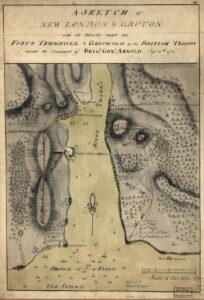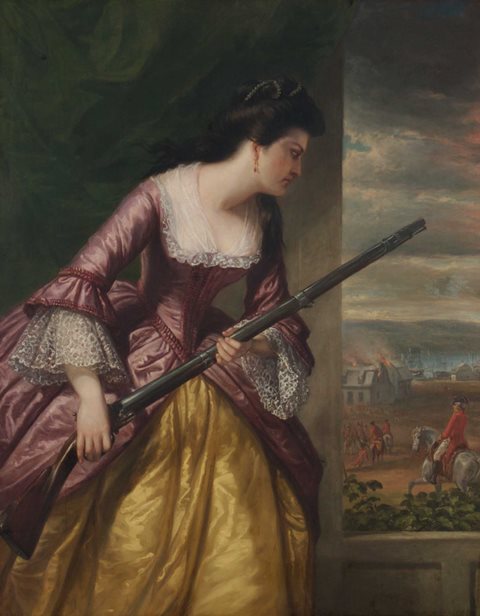By Emily Clark
New London resident Abigail Hinman, the relatively unknown wife of sea captain Elisha Hinman, allegedly made a name for herself as a patriot in 1781. Her story begins with her neighborhood under siege by the British during the American Revolution and ends with Hinman grabbing a musket and taking aim at notorious British Brigadier General Benedict Arnold who had committed treason against the American colonies just a year earlier. While Hinman’s story may be legend, it helps represent the importance of women in the story of the American Revolution.
Life in New London

A Sketch of New London and Groton with the attacks made on Forts Trumbull and Griswold by the British Troops under the command of Brig. Gen. Arnold, Sept. 6, 1781 – By Daniel Lyman, Library of Congress Geography and Map Division. Used through Public Domain.
Despite the famous depictions of Hinman’s heroism, there is little evidence of her life prior to the British raid. Born June 22, 1743, to George and Mary Dolbeare (or Dolebere/Dolbear), she married Captain Elisha Hinman in 1777 and settled with him in New London. During the American Revolution, when her husband, one of the first captains assigned to the United States Navy, was called away to sea, Abigail remained in New London with their two daughters.
In late summer of 1781, Benedict Arnold laid siege to New London (where the American colonists stored a large supply of arms). He and his soldiers raided the city, forcing the patriots to retreat. The British then prepared to burn the town as battles raged and massacres ensued at Groton Heights and Fort Griswold. Abigail Hinman, one of the few colonists who had not fled the city when the redcoats landed, watched the catastrophic events from her home with her children beside her.
A Risk to Save Her Home
Ironically, Hinman and her family had been friendly with Arnold years earlier when he lived in the nearby town of Norwich. But when he came to her home that day in September of 1781 with the intention of burning it, along with the rest of the city, Hinman allegedly confronted her former acquaintance, now an infamous traitor. Because of their prior relationship, Arnold agreed not to torch Hinman’s house or those of her neighbors. Knowing Arnold’s character, however, Hinman quite possibly doubted the sincerity of his promise.
As the story of Hinman’s legend unfolds, Arnold reportedly walked away from her home, at which point Hinman seized her husband’s musket, aimed it at the traitor, and pulled the trigger. Though the shot had no effect (due to either poor aim, a misfire, or perhaps even because the musket was not loaded), Arnold heard the noise and questioned her about it. Thinking quickly, Hinman is said to have hid the gun and attributed the noise to a chair breaking in the house. Arnold then left, unaware of what might have been, and ultimately spared several houses, including Hinman’s. The rest of New London, however, experienced great devastation. The fires destroyed approximately 145 structures and caused significant monetary damages.
Her Legacy Endures
Decades after surviving the American Revolution and witnessing the start of the new nation, Abigail Hinman died in 1816 at age 73. She is buried beside her husband Elisha in New London’s Cedar Grove Cemetery. Her monument aptly reads, “In Memory of Mrs. Abigail Hinman. Charitable to the poor, and a true friend to the distressed. She died as she lived beloved and esteemed for her many amiable qualities and virtues.”
Hinman’s story, however, did not appear in the public consciousness until years later. In the mid-1850s, 19th-century American painter Daniel Huntington, the husband of Hinman’s grandniece, immortalized the legend of Abigail Hinman. The portrait, an oil on canvas on display at the Lyman Allyn Art Museum in New London, depicts Hinman dressed in rose-colored satin and lace and holding a musket as she glances out a doorway at Benedict Arnold with a look of hostility. Other than the painting and family stories, there is currently little evidence to corroborate Hinman’s story. The legend itself, however, has become representative of the tenacity and courage of women during the American Revolution.
In February of 2020, the National Society Daughters of the American Revolution established the Abigail Hinman Chapter. This 40th chapter in Connecticut is based in Stonington, just 15 miles from Hinman’s home in New London.
Emily Clark is a freelance writer and an English and Journalism teacher at Amity Regional High School in Woodbridge.









